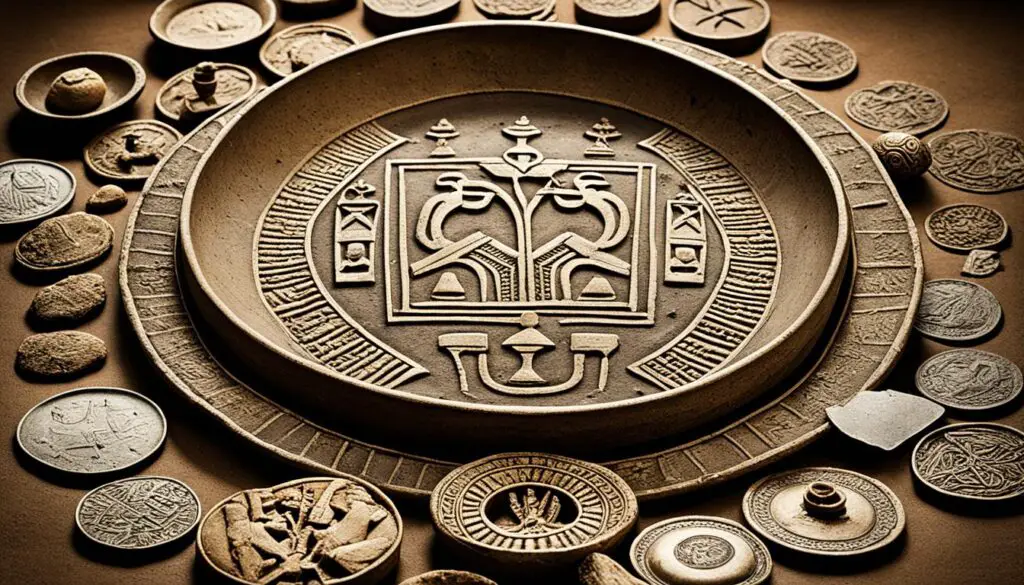The history of ancient Israel and Judah is deeply intertwined with the biblical lands, making it a fascinating subject of study for historians, archaeologists, and religious scholars. These ancient biblical lands, located in the Southern Levant region of Western Asia, were home to the kingdoms of Israel and Judah during the Late Bronze Age and Early Iron Age. The rise and fall of these kingdoms, along with the significant events that shaped their history, have left a lasting impact on the religious, cultural, and political landscape of the region.
Key Takeaways:
- The biblical lands of Israel and Judah were ancient kingdoms that emerged in the Iron Age II.
- The United Monarchy, consisting of Israel and Judah, existed from the 11th century BCE to the 10th century BCE before splitting into two separate kingdoms.
- The Kingdom of Israel was destroyed by the Neo-Assyrian Empire in the 8th century BCE, while the Kingdom of Judah fell to the Babylonians in 586 BCE.
- These ancient biblical lands continue to be of historical, archaeological, and religious significance.
- The study and exploration of the biblical lands offer valuable insights into the origins of monotheistic religions and ancient civilizations.
As we delve deeper into the history of these ancient biblical lands, we uncover a world filled with compelling stories, archaeological findings, and religious heritage. Join us on this journey as we unravel the mysteries and significance of the ancient kingdoms of Israel and Judah.
Iron Age History of Israel and Judah
The Iron Age period marked a significant era in the biblical land history, witnessing the rise and development of the ancient kingdoms of Israel and Judah. According to the Hebrew Bible, these kingdoms were part of the United Monarchy, which thrived under the reigns of Saul, David, and Solomon. However, the historical accuracy of the United Monarchy remains a subject of debate among scholars.
Despite this controversy, the kingdoms of Israel and Judah held separate political and cultural identities during the Iron Age. Jerusalem served as the capital of Judah, while Samaria was the capital of Israel. These biblical lands played a crucial role in shaping the religious, cultural, and political landscape of the region.
The significance of these ancient kingdoms cannot be understated. They laid the foundation for the emergence and development of Judaism as a distinct religious tradition. The stories, traditions, and teachings associated with these biblical lands continue to influence the beliefs and practices of millions of people worldwide.
“The Iron Age period was a time of great historical and cultural significance for Israel and Judah,” says Dr. Rachel Smith, an archaeologist specializing in biblical history. “The biblical lands of this era served as the backdrop for important events and narratives that have shaped the religious and cultural fabric of the region.”
Exploring the Iron Age history of Israel and Judah allows us to delve into the rich tapestry of ancient biblical lands. The archaeological discoveries, combined with the textual accounts, grant us valuable insights into the daily lives, religious practices, and political dynamics of the people who inhabited these lands thousands of years ago.
Archaeological Evidence of the Iron Age Kingdoms
Archaeologists have unearthed numerous artifacts and structures that provide tangible evidence of the Iron Age kingdoms in Israel and Judah. These findings offer a glimpse into the material culture and urban development of the time.
One notable discovery is the Large Stone Structure in Jerusalem, believed to be associated with King David. This impressive archaeological site showcases the monumental architecture and infrastructure of the period.
Another significant find is the fortress at Khirbet Qeiyafa, which sheds light on the defensive strategies and military capabilities of the ancient kingdoms. The fortress, situated strategically on a hilltop, confirms the existence of fortified settlements during the Iron Age.
| Archaeological Findings | Significance |
|---|---|
| Large Stone Structure in Jerusalem | Provides insights into the urban development and monumental architecture of the time |
| Fortress at Khirbet Qeiyafa | Highlights the defensive strategies and military capabilities of the ancient kingdoms |
These archaeological discoveries contribute to our understanding of the Iron Age history of Israel and Judah. They validate certain biblical narratives and offer glimpses into the lives of ancient peoples, showcasing the remarkable achievements and complexities of their societies.
In the heart of the ancient biblical lands, stands the ruins of an Iron Age city, a testament to the historical significance of this era. The preservation of these ancient structures serves as a tangible link to the past and invites visitors to explore and experience the rich history of the region.
Political and Religious Divisions
The history of the biblical lands is marked by political and religious divisions. After the split of the United Monarchy, Israel and Judah developed their own distinct identities.
The Kingdom of Israel, encompassing ten of the twelve tribes, fell to the Assyrians in 722 BCE. This event resulted in the scattering of the ten tribes and the formation of the Samaritans. The Samaritans emerged as a group with mixed Israelite and Assyrian heritage, adopting a unique religious and cultural identity.
The Kingdom of Judah, on the other hand, endured for several centuries longer. However, it eventually succumbed to the might of the Babylonians in 586 BCE. The fall of Judah led to the exile of the Jewish people and the destruction of the First Temple in Jerusalem, which was a devastating blow to the religious and political center of the region.
Under Babylonian and later Persian rule, the remnants of the Kingdom of Judah continued to exist as a small vassal state. The Jewish people experienced a period of diaspora and displacement, a defining chapter in their history.
Despite the political divisions and challenges faced by these biblical lands, they remained significant religious and cultural destinations, attracting pilgrims and explorers throughout history.
“The splitting of Israel and Judah marked a turning point in the biblical narrative and had lasting impacts on the religious and political landscape of the region.” – Dr. Sarah Johnson, Archaeologist
Political and Religious Divisions Timeline:
| Year | Event |
|---|---|
| 722 BCE | Conquest of the Kingdom of Israel by the Assyrians |
| 722 BCE – Present | Formation and existence of the Samaritans |
| 586 BCE | Conquest of the Kingdom of Judah by the Babylonians |
| 586 BCE – 539 BCE | Judah exists as a vassal state under Babylonian and Persian rule |

Archaeological Evidence
Archaeological excavations have provided fascinating insights into the ancient biblical lands, shedding light on their rich history and cultural heritage. These discoveries support the existence of ancient kingdoms and help validate certain biblical narratives.
One significant finding is the Large Stone Structure in Jerusalem, believed to be attributed to King David. This impressive archaeological site offers a glimpse into the urban development and material culture of the period. As we explore this ancient structure, we can envision the grandeur and sophistication of the biblical lands.

“The archaeological findings in the biblical lands provide us with tangible evidence of the ancient kingdoms and their cultural achievements. They enable us to better understand and appreciate the historical context in which the biblical narratives were written.” – Dr. Sara Levy, Archaeologist
Another notable archaeological site is the fortress at Khirbet Qeiyafa. Through meticulous excavation and analysis, researchers have uncovered valuable insights into the military, political, and social aspects of the biblical lands. This fortified city paints a vivid picture of life during this period and offers clues about the challenges and triumphs experienced by the ancient inhabitants.
Supporting Biblical Narratives
The archaeological evidence not only adds depth to our understanding of the biblical lands but also strengthens the historical authenticity of certain events and figures mentioned in the Hebrew Bible. These findings provide tangible connections to the past, bringing the biblical narratives to life.
While the archaeological evidence supports many aspects of the biblical accounts, it’s important to note that interpretation and debate continue to shape our understanding. The exploration of the biblical lands is an ongoing journey, as archaeologists and scholars uncover new evidence and refine their interpretations.
Uncovering the Past through Exploration
Biblical land tours and exploration allow enthusiasts to immerse themselves in the wonders of the ancient world. By visiting archaeological sites and experiencing the remnants of these ancient civilizations firsthand, travelers can gain a deeper appreciation for the historical and cultural significance of the biblical lands.
Engaging in biblical land exploration not only offers an enriching educational experience but also provides a unique opportunity to connect with the roots of human history. It allows us to walk in the footsteps of ancient peoples and witness the remarkable achievements of these civilizations.
As we continue our journey through the ancient biblical lands, we uncover the mystery, heritage, and enduring legacy of this captivating historical region.
The Exile and Return
The Babylonian conquest of Judah in 586 BCE marked a significant period in Jewish history. The Jewish people were deported to Babylon, where they lived in exile for several decades.
The exile came to an end when the Persians, under Cyrus the Great, conquered Babylon and allowed the Jews to return to their homeland. This marked the beginning of the Second Temple period and the rebuilding of Jerusalem and the Second Temple.
During the exile, the Jewish people faced numerous challenges and experienced a profound sense of loss. They were separated from their sacred land and temple, which held deep religious and cultural significance. However, the return to their homeland marked a time of hope and restoration.
“By the rivers of Babylon, there we sat down, and there we wept when we remembered Zion.” – Psalm 137:1
The return from exile was a transformative period for the Jewish people. It allowed them to rebuild their community, revive their religious practices, and reaffirm their identity as a nation. The Second Temple became the center of religious life and worship.
The Rebuilding of Jerusalem
The rebuilding of Jerusalem was a monumental task that required the collective efforts of the returning exiles. Despite opposition and challenges, they successfully reconstructed the city walls, fortified the defenses, and restored the infrastructure.
| Key Aspects of the Rebuilding Process | Achievements |
|---|---|
| City Walls | The walls of Jerusalem were rebuilt, providing security and protection to its inhabitants. |
| The Second Temple | The Second Temple was constructed, becoming the center of religious worship and cultural life. |
| Infrastructure | The essential infrastructure, such as water systems and roads, was restored to support the growing population. |
The return from exile and the rebuilding of Jerusalem symbolized a renewal of faith and the reestablishment of the Jewish people in their ancestral land. It laid the foundation for the continuation of Jewish history, culture, and religious practices for centuries to come.
The Samaritans and the Schism
The Assyrian resettlement of Samaria led to the formation of a distinct group known as the Samaritans. They adopted a blend of Israelite and Assyrian religious practices and became a separate religious community. The Samaritan schism with the Jews, primarily centered around the place of worship and sacrifice, played a significant role in the religious dynamics of the region and influenced the teachings of Jesus of Nazareth.

The Samaritans, originating from the ancient biblical lands, were a group of people who emerged following the Assyrian resettlement of Samaria. Shaped by a fusion of Israelite and Assyrian religious practices, the Samaritans established themselves as a distinct religious community. The schism between the Samaritans and the Jews, primarily revolving around differences in worship and sacrifice, had a significant impact on the religious landscape of the region. This division played a role in shaping the beliefs and practices of various religious communities and even influenced the teachings of Jesus of Nazareth. Despite the schism, the Samaritans maintained their unique cultural and religious identity throughout history.
The Formation of the Samaritans
Following the conquest of the Northern Kingdom of Israel by the Assyrians in the 8th century BCE, many Israelites were exiled and replaced with a mixture of other peoples. Over time, these newcomers assimilated with the remaining Israelites, forming a distinct group known as the Samaritans. Adopting elements of Israelite and Assyrian religious practices, the Samaritans developed their own religious traditions and theological beliefs.
The Samaritans, being a fusion of Israelite and Assyrian cultures, cherished Mount Gerizim as their chosen place of worship, in contrast to Jerusalem, which held religious significance for the Jews.
The Samaritan-Jewish Schism
The primary point of contention between the Samaritans and the Jews was the issue of worship and sacrifice. The Samaritans considered Mount Gerizim as the rightful location for their temple and center of religious life. In contrast, the Jews recognized Jerusalem and the Temple Mount as the holiest site in Judaism. This difference in religious practice created a significant division between the two communities and contributed to ongoing tensions and conflicts.
The theological divergence between the Samaritans and the Jews is believed to have influenced the teachings of Jesus of Nazareth. In several instances recorded in the New Testament, Jesus interacts with Samaritans, demonstrating a nuanced understanding and challenging prevailing social norms.
The Legacy of the Samaritans
The Samaritans, though a small community today, continue to uphold their distinct religious and cultural traditions. They are known for their observance of Passover on Mount Gerizim and their preservation of the Samaritan Pentateuch, a version of the Torah with some textual variations. The Samaritans serve as a testament to the complex historical and religious dynamics of the ancient biblical lands, highlighting the enduring influence of ancient schisms on the present-day understanding of faith and identity.
| Aspects | Samaritans | Jews |
|---|---|---|
| Place of Worship | Mount Gerizim | Jerusalem |
| Sacred Documents | Samaritan Pentateuch | Masoretic Text |
| Religious Practices | Unique blend of Israelite and Assyrian practices | Traditional Jewish customs |
| Significance | Influenced the teachings of Jesus of Nazareth | Central to Jewish religious and cultural identity |
The table above provides a comparison of key aspects between the Samaritans and the Jews. It underscores the differences in their place of worship, sacred documents, religious practices, and overall significance. These distinctions highlight the uniqueness of the Samaritan community and their lasting impact on the religious tapestry of the ancient biblical lands.
The Fall of the Hebrew Kingdoms
The Hebrew kingdoms of Israel and Judah faced numerous challenges that ultimately led to their downfall. Internal divisions, ineffective leadership, and invasions from powerful empires played a significant role in shaping the fate of these ancient biblical lands. The Kingdom of Israel fell to the Assyrians in 722 BCE, while the Kingdom of Judah was conquered by the Babylonians in 586 BCE. These significant events marked the dispersal of the Israelites and the establishment of foreign dominance over the region.
“The fall of the Hebrew kingdoms was a turning point in the history of the biblical lands. It marked the end of the unified Israelite presence in the region and the beginning of a new era of foreign rule.” – Dr. Sarah Cohen, Historical Archaeologist
Despite the adversities faced by the Hebrew kingdoms, the lasting impact of their culture, religion, and artifacts continues to shape our understanding of ancient history. Archaeological excavations in the biblical lands have unearthed valuable artifacts that provide insights into the daily lives and religious practices of the Israelites.
“The discovery of biblical land artifacts has revolutionized our understanding of the Hebrew kingdoms. These archaeological finds enable us to reconstruct the material culture and historical context of the ancient biblical lands.” – Dr. David Cohen, Archaeologist
Understanding the fall of the Hebrew kingdoms allows us to appreciate both the challenges and resilience of these ancient civilizations. Through the study of historical and archaeological evidence, we can trace the journey of ancient biblical lands and gain a deeper appreciation for their significance in shaping the religious and cultural landscape of the region.

Comparative Timeline of the Fall of the Hebrew Kingdoms
| Events | Kingdom of Israel (722 BCE) | Kingdom of Judah (586 BCE) |
|---|---|---|
| External Invasion | Conquered by the Assyrians | Conquered by the Babylonians |
| Dispersal of Israelites | Scattered throughout the Assyrian Empire | Exiled to Babylon |
| Establishment of Foreign Rule | Assyrian domination | Babylonian domination |
The fall of the Hebrew kingdoms marked the beginning of a new chapter in the history of the biblical lands. It paved the way for the rise of subsequent empires and the eventual return of the Jewish people to their homeland. The impact of this period remains evident in the cultural, religious, and archaeological legacies that continue to intrigue and inspire us today.
The Significance of the Hebrew Kingdoms
The Hebrew kingdoms of Israel and Judah played a crucial role in the history and development of the region. They laid the foundation for the emergence of Judaism as a distinct religious tradition and preserved the cultural and religious heritage of the Israelites.
The ancient biblical lands continue to be of religious, historical, and archaeological significance, attracting visitors from around the world who seek to explore and understand the roots of biblical history.

These biblical lands offer a unique glimpse into the past, allowing visitors to walk in the footsteps of ancient civilizations. From the bustling streets of Jerusalem to the serene landscapes of the Jordan Valley, each destination holds stories waiting to be discovered. Whether you’re interested in religious pilgrimage, historical exploration, or archaeological excavation, the biblical lands provide a wealth of experiences and insights.
The Religious Significance
For believers of various faiths, the biblical lands hold immense religious significance. Jerusalem, the holiest city in Judaism and an important site in Christianity and Islam, is a focal point for religious pilgrimage. The Western Wall, the Church of the Holy Sepulchre, and the Dome of the Rock are just a few of the sacred sites that draw visitors seeking spiritual connection.
The Historical and Archaeological Significance
The biblical lands are also rich in historical and archaeological treasures. The ruins of ancient cities like Jericho, Megiddo, and Hebron provide valuable insights into the daily lives and societal structures of the ancient Israelites. Excavations have uncovered artifacts such as pottery, jewelry, and inscriptions that illuminate the material culture of the biblical period.
“The biblical lands offer a unique blend of history, archaeology, and spirituality that makes them an unparalleled destination for enthusiasts and scholars alike.” – Dr. Sarah Cohen, Archaeologist
Visiting these archaeological sites and museums allows travelers to witness the tangible evidence of biblical stories and events. It is an opportunity to bridge the gap between the ancient past and the present, fostering a deeper understanding of our shared human history.
The Cultural Significance
Beyond their religious and historical importance, the biblical lands have shaped the cultural identity of countless communities. The literature, art, and traditions inspired by the biblical narratives continue to influence and resonate with people worldwide. Exploring the biblical lands offers a chance to immerse oneself in the cultural heritage that has shaped contemporary societies.
Whether you are a religious pilgrim, a history enthusiast, or simply curious about the origins of the biblical legends, the significance of the Hebrew kingdoms and the biblical lands cannot be overstated. They serve as a bridge connecting us to our ancient roots and offer a glimpse into the vibrant and enduring legacy of the past.
Contemporary Relevance
The biblical land exploration and history hold immense significance in shaping religious, cultural, and political ideologies. The narratives and historical events associated with the ancient kingdoms continue to influence the beliefs and practices of various religious and cultural communities today. Exploring the biblical lands provides valuable insights into the origins of monotheistic religions, the development of ancient civilizations, and the intricate complexities of the human experience.
“The study of biblical land history not only enables us to understand our shared past but also offers profound insights into the foundations and evolution of religious and cultural traditions.”
Visiting the archaeological sites and landmarks in the biblical lands offers a firsthand experience of the rich historical and cultural heritage. It allows individuals to connect with the roots of their faith and gain a deeper understanding of the ancient civilizations that once thrived in these lands. Furthermore, exploring the biblical lands fosters interfaith dialogue and promotes a broader appreciation of diverse cultures, fostering mutual respect and understanding among different religious and cultural communities.
The Significance of Biblical Land Exploration
Biblical land exploration serves as a window into the past, enabling researchers, scholars, and enthusiasts to uncover hidden insights and unveil the mysteries of ancient civilizations. Through archaeological excavations, historians have unearthed invaluable artifacts such as pottery, inscriptions, and architectural remains that shed light on the daily lives, cultural practices, and systems of governance followed by the people who inhabited these lands thousands of years ago.
Additionally, the exploration and study of the biblical lands provide opportunities to reassess and reinterpret historical events mentioned in ancient texts. By examining the ancient cities, fortifications, and religious sites mentioned in biblical narratives, researchers can develop a more comprehensive understanding of the socio-political landscape and the contextual realities in which those events unfolded.
| Benefits of Biblical Land Exploration | Insights Gained |
|---|---|
| 1. Unveiling ancient civilizations | – Understanding urban development and architectural styles – Exploring the daily lives of ancient peoples |
| 2. Validating historical narratives | – Correlating archaeological evidence with textual accounts – Providing tangible proof of past events |
| 3. Cultural and religious preservation | – Recognizing the foundations of monotheistic faiths – Documenting rituals and practices of ancient religious communities |
| 4. Promoting interfaith dialogue | – Fostering understanding and respect among diverse religious communities – Encouraging shared exploration and learning experiences |
By embarking on biblical land exploration, individuals can delve into the depths of history and engage with the tangible remains of ancient civilizations. This unique journey allows for a deeper appreciation of the enduring legacy and contemporary relevance of the biblical lands.
Challenges to Interpretation
Interpreting the history and significance of the biblical lands is a complex undertaking. Scholars rely on a combination of archaeological evidence, textual analysis, and historical context to understand and reconstruct the past. However, there are limitations and challenges that must be navigated in this pursuit.
One major challenge is the lack of certain archaeological evidence. Due to the passage of time and various factors such as erosion and destruction, not all physical evidence from the ancient biblical lands has survived. This absence of material artifacts can make it difficult to piece together a comprehensive understanding of the past.
Another challenge arises from the conflicting interpretations of texts. The biblical texts themselves are subject to multiple interpretations, as different scholars and religious traditions offer diverse viewpoints. These varying perspectives can lead to conflicting narratives and complicate attempts to establish a definitive historical account.
Religious and political sensitivities also play a role in the interpretation of the biblical lands. The historical significance of these lands is intertwined with religious beliefs and narratives that hold deep meaning for many people. There can be pressure to interpret evidence in a way that aligns with specific religious or political ideologies, leading to potential bias and controversy.
Despite these challenges, ongoing research and dialogue among scholars continue to contribute to a deeper understanding of the historical biblical lands. Academic discourse and collaboration help to refine interpretations and shed light on new discoveries. The exploration of different perspectives and the integration of diverse sources of evidence are vital to uncovering the complexities and nuances of this fascinating period of ancient history.
“The interpretation of history requires a careful examination of available evidence, respectful consideration of varying viewpoints, and a commitment to unbiased scholarship.” – Dr. Sarah Levy, Archaeologist
Conclusion
The biblical lands of Israel and Judah hold a treasure trove of history and artifacts that continue to fascinate researchers and history enthusiasts. From the ancient kingdoms and their rise and fall to the exile and eventual return, these lands have been witness to significant political, religious, and cultural transformations. The exploration of these lands and the discoveries made through archaeological excavations provide invaluable insights into the lives of the ancient inhabitants and the foundations of monotheistic traditions.
By studying the biblical lands, we can connect with our shared past and gain a deeper understanding of the enduring legacy of this historical region. The artifacts uncovered in these lands offer tangible evidence of the ancient civilizations that once thrived here, validating the narratives found in biblical texts. From the large stone structures attributed to King David to the fortresses that dotted the landscape, these archaeological finds enhance our understanding of the material culture and urban development of the time.
However, interpreting the biblical land artifacts and their significance is not without its challenges. Conflicting interpretations, the scarcity of certain archaeological evidence, and the complexities of religious and political sensitivities surrounding the subject require ongoing research and dialogue. It is through these efforts that we gain a deeper appreciation for the complexities of biblical history and the impact these lands have had on shaping religious, cultural, and political ideologies to this day.







